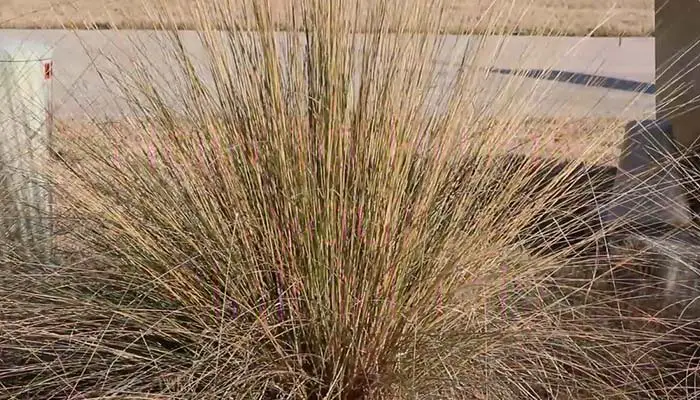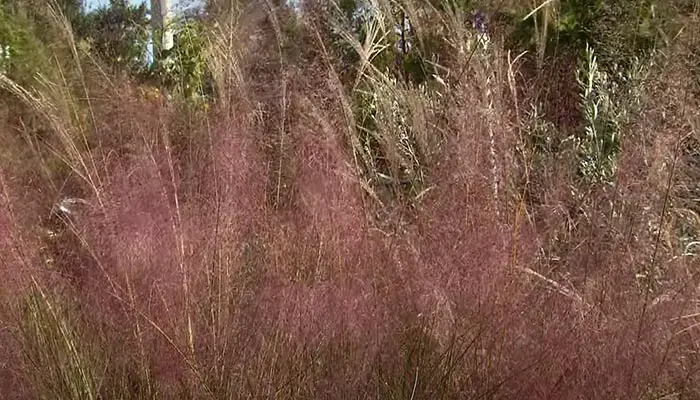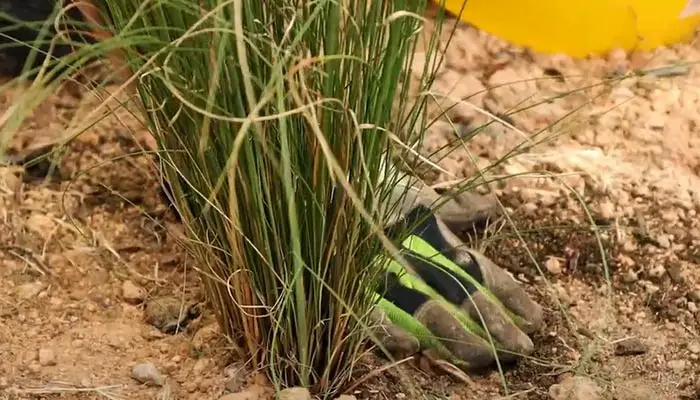If you are wondering why the new addition in your garden is the pink muhly grass turning brown, then know that it is natural for the growth of last season. It occurs at the end of the growing season to accelerate new growth.
However, there could be some other unwanted reasons as well including overwatering, sunlight issues, unbalanced fertilizer, pest and disease attacks, and others.
Nonetheless, if the reasons are unexpected then there are treatments as well. Prompt treatment can save your muhly grass.
Thus, if you want to know the reasons and at the same time solutions for them then read the article till the end.
| Reason | Fixing Guide |
| Natural Reason | Proper care |
| Watering issues | Watering when the soil gets dry |
| Soil condition | Replace with sandy or rocky soil |
| Sunlight issue | Ensure 4 to 6 hours of sunlight |
| Wrong Fertilizer | Apply slow-release fertilizer |
| Pests and diseases | Apply fungicides |
| Wrong planting and caring | Maintain seasonal activities |
Why My Pink Muhly Grass is Turning Brown – 7 Causes With Solutions

1. Natural Cause
If you find brown tips in your pink muhly grass at the end of the season, then know that the reason is natural. It happens to the previous season’s growth and when the temperature is cold. It is basically a signal that indicates the plant has reached its growing season.
Pink Muhly is a warm-season grass. Hence, when it gets older, new growth comes with its dying back. And this entire process is considered normal. In fact, it is necessary for the newer growth of the grass.
However, in such situations, the grass also requires some care and control measures. It is necessary to make the new growth better.
Control Measure
- In this case, trim off the brown part or dying grass when the season ends and its new growing season starts.
- Removing the brown grass will induce the spring growth of pink muhly grass and also make shiny blades.
2. Watering Issues
Among all unexpected reasons, improper watering, however, is arguably the most crucial reason for your muhly grass turning brown. Both overwatering and underwatering cause this trouble to the grass.
It is a common mistake that is made by even many professional gardeners out there. The grass is best suited in arid regions. And also, rocky soil is considered best for its thriving. So, areas with low water are preferred by them.
Thus, if you overwater, the grass will surely overreact. Overwatering can cause several diseases to the roots and it can spread to the grass blades making them turn brown or black in color.
Again, underwater can also cause damage to the plant. Especially after planting or transplanting the pink muhly grass, frequent watering is necessary. So, that time if you do not provide the right amount of water then the blades of the pink muhly will wilt and turn brown.
Control Measure
- Apply water especially when you have just planted or transplanted your pink muhly grass.
- Also, avoid watering during rainy days and wet winter days. Pink muhly grass hardly survives wet winter. Thus, watering during this period will affect their root and blades.
- Once the grass establishes, no need to water it frequently. However, in hot weather watering is necessary
- Thus, apply the two-finger test first if the grass is potted. If the soil feels dry, then apply a decent amount of water to a depth of 1 or 1.5 inches of soil in a week. (Our Pick: XLUX Soil Moisture Meter)
- Lastly, when the pink muhly grass is in a dormant period. Watering during the dormancy period might stress the grass and it mind end up not thriving at all.
3. Soil Condition
Soil condition matters a lot especially when you are planting ornamental plants. Poor soil conditions can destroy the entire grass making the blades brown and dead and drop. It will also not allow the pink muhly grass to bloom.
Though the grass does not ask for rich soil. In fact, they can survive in almost all types of soil. However, pink muhly thrives well in sandy or rocky soil.
Again, compact soil can also affect the growth of pink muhly grass. Because of the compactness, the roots of the grass cannot transport nutrients to the grass blades. Thus, the lack of nutrients makes the grass starve and ends up browning the blades.
Moreover, if the soil is not well-drained then after watering on a rainy day the water will create a stagnant situation. This situation will not allow the nutrients to take up by the roots. Hence, the consequence will be the same as we have just stated in the case of compact soil.
Thus, clay soil also makes the growth of pink muhly stunted and by browning the plants it establishes an unhealthy plant.
Control Measure
- If you see the problem is in the soil, then you might have to change the soil with a fresh one. It is easier if your pink muhly grass is potted. Replace the soil with better texture and well-draining capacity.
- Again, if you are about to plant grass in your garden, make sure the soil is not clay but rather sandy for ensuring healthy growth.
- Also, never let the soil dry for too long. The roots of a plant cannot uptake nutrients from the dry soil. Thus, the grass is going to starve and eventually turn yellowish or brown.
4. Sunlight Issue

You already know that muhly pink grasses are best suited in arid areas. Hence, the grass likes dry and hot conditions. So, insufficient sunlight will cause them huge problems including stunting growth and making the edge of the blades brown.
Most of the time, other plants and or roofs provide shade to the grass and it becomes deprived of sunlight.
Again, scorching sunlight will also cause problems to the pink muhly. It is obvious that temperatures more than a certain point will harm the plant. It can make the blades wilt and brown without letting them bloom. Also, the dropping of the blades can take place.
However, pink muhly manages to grow even under insufficient sunlight and bloom as well. But it will not look healthy at all. This is the same case for more than adequate sunlight.
Generally, more than 7 to 8 hours of direct sunlight will make the difference from green to brown. Hence, proper care has to be ensured.
Control Measure
- First of all, do not plant the grass under a big tree or roof, where it will get
- You have to make sure that your pick muhly grass is receiving at least 4 to 6 hours of direct sunlight daily.
- Also, place your potted pink muhly in place of your room where direct sunlight can enter through the window.
- If you have already planted the muhly grass in a shady area, then we will suggest transferring the grass immediately. Once you manage to transfer the grass from a shady area to an area where it gets sunlight, you can witness a drastic change. With blooms, the grass will look healthy and great.
5. Wrong Fertilizer
Fertilization is important to save your ornamental plant from becoming brown or yellow. Not necessary that the soil where your pink muhly is growing has to be highly fertile. Yet, without supplying essential nutrients, the muhly grass will surely react.
Nonetheless, not all soil is also going to be rich in nutrient elements. Hence, making them rich in nutrients by applying fertilizer is important.
Moreover, among all essential nutrients, nitrogen and phosphorus are two elements that make the plant look green, healthy, and flowery.
Hence, deficiency of these two elements will affect the old blades of pink muhly and turn them into yellow and then brown.
Then again, too much nitrogen supply can kill the pink muhly in the same way. It will even affect the young grass as well. Thus, a balanced application of fertilizer is always recommended. Especially when you want to transplant the grass knowing the soil fertility is important.
Control Measure
- Before transplanting the muhly grass, check the soil where you are going to plant it. Professionals suggest making a soil pH test. The test will let you know if the soil requires fertilization or not.
- However, while applying fertilizer make sure that you are adopting the right ratios. Hence, a balanced and the best fertilizer of N-P-K or a slow-release fertilizer for pink muhly grass will do the job well. Using a specific fertilizer than a general fertilizer will be more effective.
- Apply fertilizer after planting or transplanting the grass. Do not apply fertilizer when the grass is about to bloom.
- Fertilizing during summer becomes fruitful to have greener blades and beautiful blooms in spring.
- Also, if you notice the pink muhly did not bloom well in the previous year, then this year apply fertilizer must.
6. Pests and Diseases
Unlike other ornamental plants, pink muhly grass is hardly attacked by any pests or diseases. But at times, the environment becomes susceptible for them to attack the grass and turn it brown. Among all diseases, grass rust makes the entire plant look rusty and brown.
Again, because of several fungal infections, the browning of muhly grass can take place. The fungus can attack when the temperatures are extreme and the soil is wet for too long.
Control Measure
- Watering at the right time can save your pink muhly grass from being attacked by fungus. Hence, professional gardeners suggest watering the plant very early in the morning.
- Again, ensure better ventilation or air circulation where your pink muhly grass is located. It is important especially if the weather is hot and humid.
- Also, thinning the muhly grass also protects it from the attack of several pests and diseases. It also allows better circulation of air to the entire plant. It reduces harboring of several diseases and pests to a great extent.
- Nonetheless, you have to pick up and destroy the affected parts of the grass. otherwise, the infection will spread to the entire pink muhly.
- Also, to prevent the fungal attack, you adopt some homemade remedies like spraying neem oil.
- However, if the fungal attack is severe then you can apply the best commercial fungicide [our pick] for pink muhly grass.
7. Wrong Planting and Caring
Last but not least, wrong planting and caring can totally destroy your pink muhly by making it brown and black and then dropping. Many gardeners out there plant their pink muhly grass in the wrong season.

Winter is never the best season for planting pink muhly since the grass evolves in dry and hot weather. So, planting the grass at the end of the season will not offer you a healthy plant. Rather it will make offer deformed blades with some weird brown color.
Again, while taking care of the grass, many gardeners adopt the wrong method. When the grass grows tall and floppy, thinning or mowing becomes important to get a better result.
But unfortunately, many gardeners do it the wrong way by following the wrong method. Most of them do it at the wrong time. Also, while thinning, many do the mistake of cutting the blades extremely short. It gives the plant an unbearable shock.
Moreover, cutting the grass at the wrong time like during autumn will affect the blades and blooms.
Control Measure
- Plant your muhly grass in the spring or early autumn. These seasons are considered the best time for planting grass.
- Try to thin the pink muhly when the time is right and the blades are tall enough.
- Do not give the plant a shock by cutting the blades too short.
FAQs
Q: Should muhly grass be cut back?
Ans: Yes, why not! You can cut back muhly grass during midwinter. Cut the grass close to its ground level. It stimulates growth and ensures the healthy growth of the grass.
Q: Does pink muhly grass survive winter?
Ans: Fortunately, pink muhly grass survives winter very well until you maintain its care. Though the plant is carefree during summer, during winter it requires some attention.
Q: What does muhly grass look like in the winter?
Ans: In summer, the grass looks amazing with pink plumes. But in winter, it becomes brown or straw color due to temperature drop.
Final Words
Now that you know the reasons for your pink muhly grass turning brown, you should keep in head the control measures as well.
Pink muhly grass is surely low-maintenance but a little bit of care is a must to make it slay with its pink plumes.
Therefore, if our article has been helpful enough for you then let us through one of your feedback!
Happy Gardening.
- Propagating Plumeria Trees from Cuttings: Easy Steps - July 13, 2024
- How to Plant Plumeria Clippings? Easy Growth Guide - July 12, 2024
- How to Make a Plumeria Bloom? Secret Tips Revealed! - July 12, 2024

